Critical Analysis of Study Skills for Higher Education: Report
VerifiedAdded on 2023/02/02
|6
|1332
|84
Report
AI Summary
This report examines study skills in higher education, focusing on the impact of cultural dimensions on learning approaches and strategies. It begins by defining study skills and their application in academic settings. The report then critically evaluates cultural dimensions, including individualism/collectivism, uncertainty avoidance, power distance, and masculinity/femininity, as proposed by Hofstede, and their influence on business and learning environments. The analysis includes justifications for the impact of these dimensions, such as the advantages of collectivism and the importance of risk-taking. The report suggests that organizations should understand cultural differences to adapt strategies and improve outcomes. Finally, it concludes that understanding cultural dimensions is crucial for effective implementation of plans and strategies and for bridging gaps between different societies, supported by references to relevant academic sources.

Study Skills
For
Higher Education
For
Higher Education
Paraphrase This Document
Need a fresh take? Get an instant paraphrase of this document with our AI Paraphraser
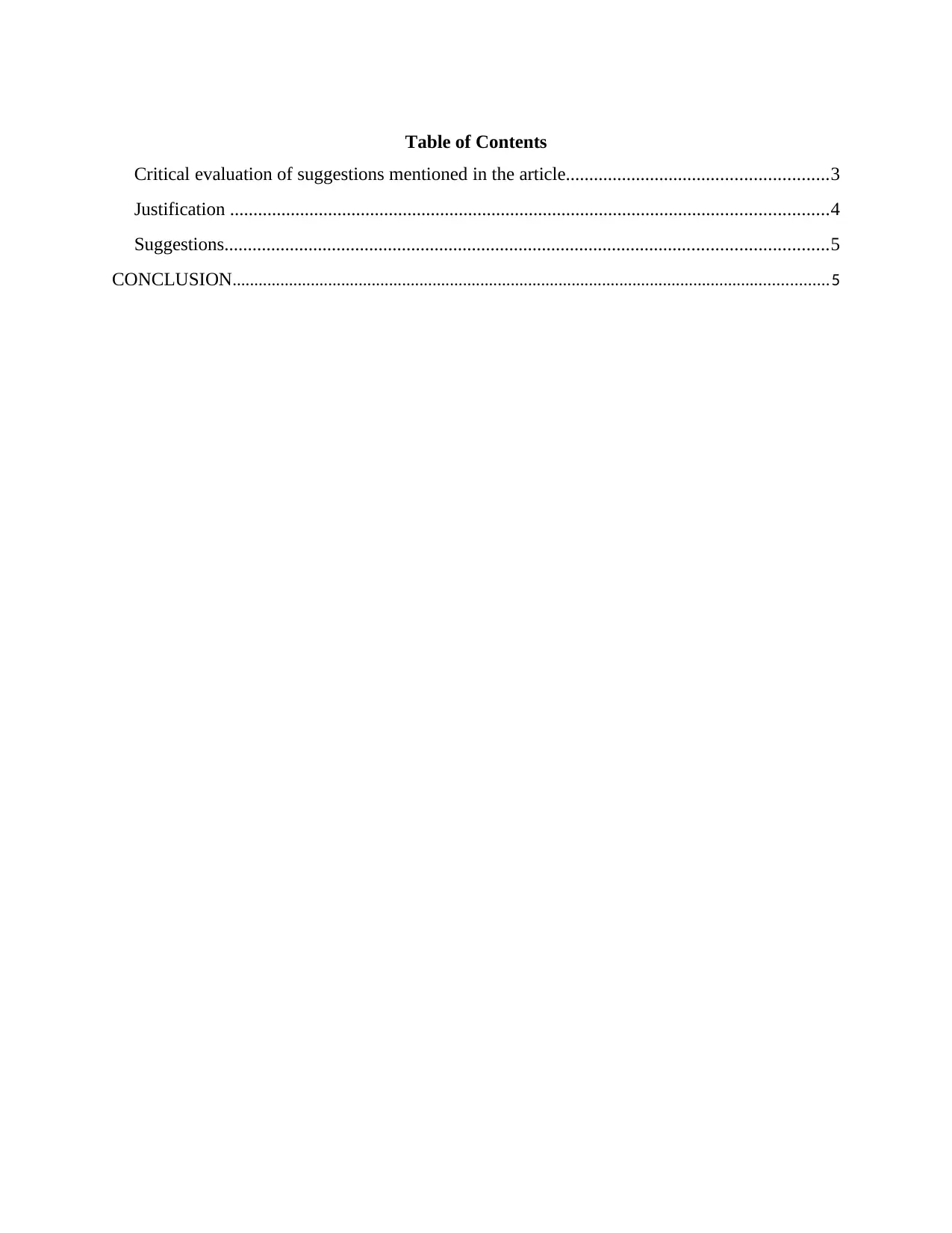
Table of Contents
Critical evaluation of suggestions mentioned in the article........................................................3
Justification ................................................................................................................................4
Suggestions.................................................................................................................................5
CONCLUSION.........................................................................................................................................5
Critical evaluation of suggestions mentioned in the article........................................................3
Justification ................................................................................................................................4
Suggestions.................................................................................................................................5
CONCLUSION.........................................................................................................................................5
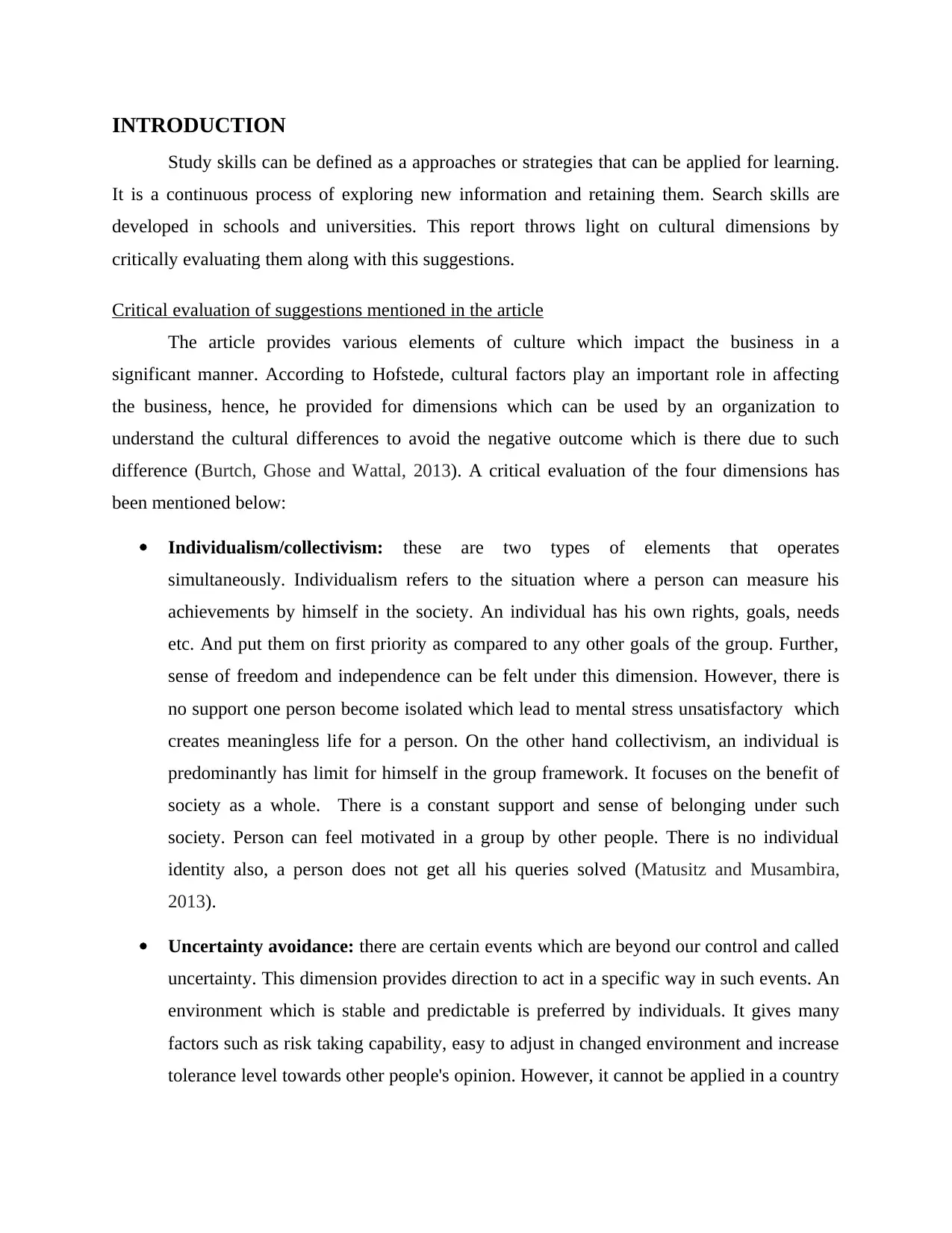
INTRODUCTION
Study skills can be defined as a approaches or strategies that can be applied for learning.
It is a continuous process of exploring new information and retaining them. Search skills are
developed in schools and universities. This report throws light on cultural dimensions by
critically evaluating them along with this suggestions.
Critical evaluation of suggestions mentioned in the article
The article provides various elements of culture which impact the business in a
significant manner. According to Hofstede, cultural factors play an important role in affecting
the business, hence, he provided for dimensions which can be used by an organization to
understand the cultural differences to avoid the negative outcome which is there due to such
difference (Burtch, Ghose and Wattal, 2013). A critical evaluation of the four dimensions has
been mentioned below:
Individualism/collectivism: these are two types of elements that operates
simultaneously. Individualism refers to the situation where a person can measure his
achievements by himself in the society. An individual has his own rights, goals, needs
etc. And put them on first priority as compared to any other goals of the group. Further,
sense of freedom and independence can be felt under this dimension. However, there is
no support one person become isolated which lead to mental stress unsatisfactory which
creates meaningless life for a person. On the other hand collectivism, an individual is
predominantly has limit for himself in the group framework. It focuses on the benefit of
society as a whole. There is a constant support and sense of belonging under such
society. Person can feel motivated in a group by other people. There is no individual
identity also, a person does not get all his queries solved (Matusitz and Musambira,
2013).
Uncertainty avoidance: there are certain events which are beyond our control and called
uncertainty. This dimension provides direction to act in a specific way in such events. An
environment which is stable and predictable is preferred by individuals. It gives many
factors such as risk taking capability, easy to adjust in changed environment and increase
tolerance level towards other people's opinion. However, it cannot be applied in a country
Study skills can be defined as a approaches or strategies that can be applied for learning.
It is a continuous process of exploring new information and retaining them. Search skills are
developed in schools and universities. This report throws light on cultural dimensions by
critically evaluating them along with this suggestions.
Critical evaluation of suggestions mentioned in the article
The article provides various elements of culture which impact the business in a
significant manner. According to Hofstede, cultural factors play an important role in affecting
the business, hence, he provided for dimensions which can be used by an organization to
understand the cultural differences to avoid the negative outcome which is there due to such
difference (Burtch, Ghose and Wattal, 2013). A critical evaluation of the four dimensions has
been mentioned below:
Individualism/collectivism: these are two types of elements that operates
simultaneously. Individualism refers to the situation where a person can measure his
achievements by himself in the society. An individual has his own rights, goals, needs
etc. And put them on first priority as compared to any other goals of the group. Further,
sense of freedom and independence can be felt under this dimension. However, there is
no support one person become isolated which lead to mental stress unsatisfactory which
creates meaningless life for a person. On the other hand collectivism, an individual is
predominantly has limit for himself in the group framework. It focuses on the benefit of
society as a whole. There is a constant support and sense of belonging under such
society. Person can feel motivated in a group by other people. There is no individual
identity also, a person does not get all his queries solved (Matusitz and Musambira,
2013).
Uncertainty avoidance: there are certain events which are beyond our control and called
uncertainty. This dimension provides direction to act in a specific way in such events. An
environment which is stable and predictable is preferred by individuals. It gives many
factors such as risk taking capability, easy to adjust in changed environment and increase
tolerance level towards other people's opinion. However, it cannot be applied in a country
⊘ This is a preview!⊘
Do you want full access?
Subscribe today to unlock all pages.

Trusted by 1+ million students worldwide
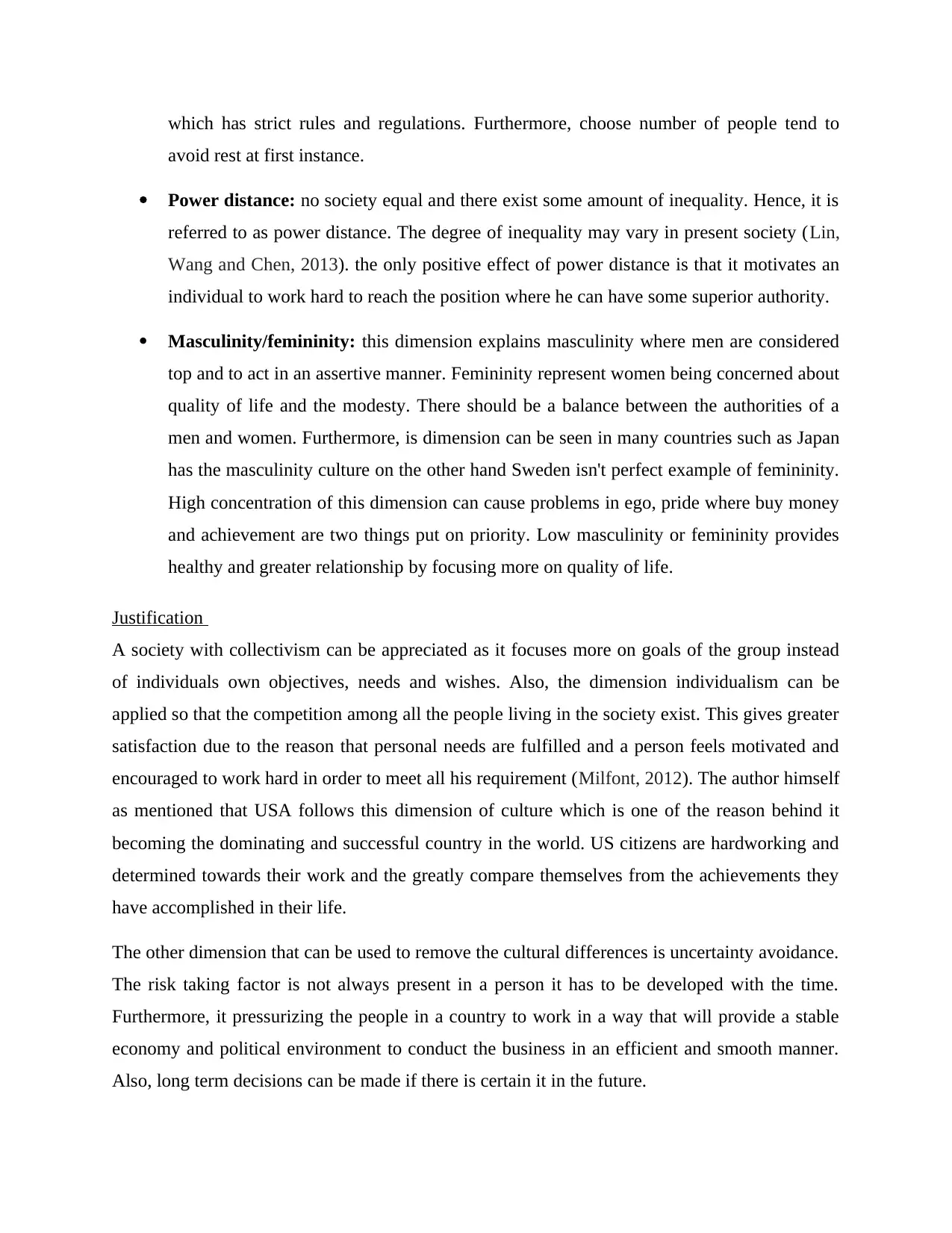
which has strict rules and regulations. Furthermore, choose number of people tend to
avoid rest at first instance.
Power distance: no society equal and there exist some amount of inequality. Hence, it is
referred to as power distance. The degree of inequality may vary in present society (Lin,
Wang and Chen, 2013). the only positive effect of power distance is that it motivates an
individual to work hard to reach the position where he can have some superior authority.
Masculinity/femininity: this dimension explains masculinity where men are considered
top and to act in an assertive manner. Femininity represent women being concerned about
quality of life and the modesty. There should be a balance between the authorities of a
men and women. Furthermore, is dimension can be seen in many countries such as Japan
has the masculinity culture on the other hand Sweden isn't perfect example of femininity.
High concentration of this dimension can cause problems in ego, pride where buy money
and achievement are two things put on priority. Low masculinity or femininity provides
healthy and greater relationship by focusing more on quality of life.
Justification
A society with collectivism can be appreciated as it focuses more on goals of the group instead
of individuals own objectives, needs and wishes. Also, the dimension individualism can be
applied so that the competition among all the people living in the society exist. This gives greater
satisfaction due to the reason that personal needs are fulfilled and a person feels motivated and
encouraged to work hard in order to meet all his requirement (Milfont, 2012). The author himself
as mentioned that USA follows this dimension of culture which is one of the reason behind it
becoming the dominating and successful country in the world. US citizens are hardworking and
determined towards their work and the greatly compare themselves from the achievements they
have accomplished in their life.
The other dimension that can be used to remove the cultural differences is uncertainty avoidance.
The risk taking factor is not always present in a person it has to be developed with the time.
Furthermore, it pressurizing the people in a country to work in a way that will provide a stable
economy and political environment to conduct the business in an efficient and smooth manner.
Also, long term decisions can be made if there is certain it in the future.
avoid rest at first instance.
Power distance: no society equal and there exist some amount of inequality. Hence, it is
referred to as power distance. The degree of inequality may vary in present society (Lin,
Wang and Chen, 2013). the only positive effect of power distance is that it motivates an
individual to work hard to reach the position where he can have some superior authority.
Masculinity/femininity: this dimension explains masculinity where men are considered
top and to act in an assertive manner. Femininity represent women being concerned about
quality of life and the modesty. There should be a balance between the authorities of a
men and women. Furthermore, is dimension can be seen in many countries such as Japan
has the masculinity culture on the other hand Sweden isn't perfect example of femininity.
High concentration of this dimension can cause problems in ego, pride where buy money
and achievement are two things put on priority. Low masculinity or femininity provides
healthy and greater relationship by focusing more on quality of life.
Justification
A society with collectivism can be appreciated as it focuses more on goals of the group instead
of individuals own objectives, needs and wishes. Also, the dimension individualism can be
applied so that the competition among all the people living in the society exist. This gives greater
satisfaction due to the reason that personal needs are fulfilled and a person feels motivated and
encouraged to work hard in order to meet all his requirement (Milfont, 2012). The author himself
as mentioned that USA follows this dimension of culture which is one of the reason behind it
becoming the dominating and successful country in the world. US citizens are hardworking and
determined towards their work and the greatly compare themselves from the achievements they
have accomplished in their life.
The other dimension that can be used to remove the cultural differences is uncertainty avoidance.
The risk taking factor is not always present in a person it has to be developed with the time.
Furthermore, it pressurizing the people in a country to work in a way that will provide a stable
economy and political environment to conduct the business in an efficient and smooth manner.
Also, long term decisions can be made if there is certain it in the future.
Paraphrase This Document
Need a fresh take? Get an instant paraphrase of this document with our AI Paraphraser
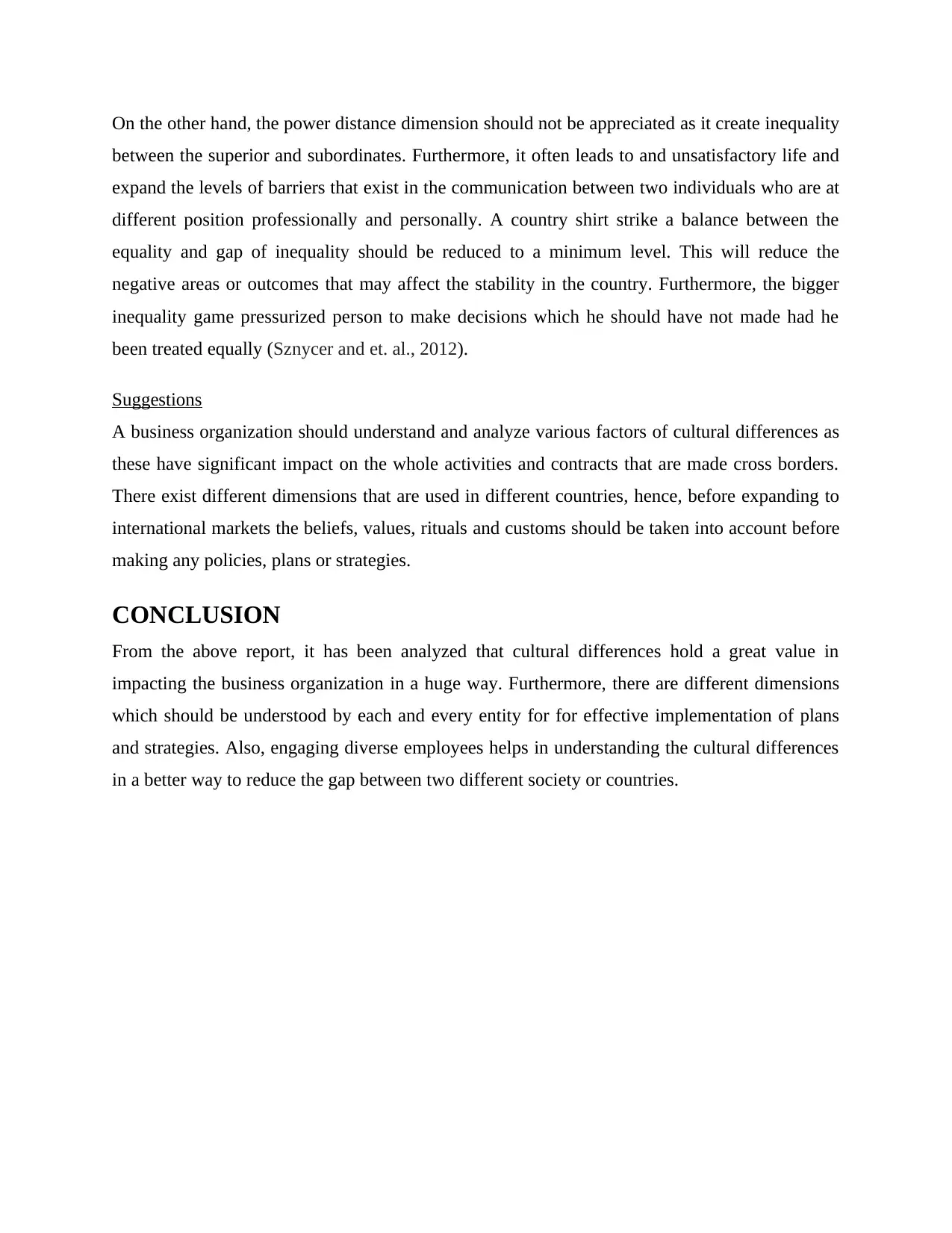
On the other hand, the power distance dimension should not be appreciated as it create inequality
between the superior and subordinates. Furthermore, it often leads to and unsatisfactory life and
expand the levels of barriers that exist in the communication between two individuals who are at
different position professionally and personally. A country shirt strike a balance between the
equality and gap of inequality should be reduced to a minimum level. This will reduce the
negative areas or outcomes that may affect the stability in the country. Furthermore, the bigger
inequality game pressurized person to make decisions which he should have not made had he
been treated equally (Sznycer and et. al., 2012).
Suggestions
A business organization should understand and analyze various factors of cultural differences as
these have significant impact on the whole activities and contracts that are made cross borders.
There exist different dimensions that are used in different countries, hence, before expanding to
international markets the beliefs, values, rituals and customs should be taken into account before
making any policies, plans or strategies.
CONCLUSION
From the above report, it has been analyzed that cultural differences hold a great value in
impacting the business organization in a huge way. Furthermore, there are different dimensions
which should be understood by each and every entity for for effective implementation of plans
and strategies. Also, engaging diverse employees helps in understanding the cultural differences
in a better way to reduce the gap between two different society or countries.
between the superior and subordinates. Furthermore, it often leads to and unsatisfactory life and
expand the levels of barriers that exist in the communication between two individuals who are at
different position professionally and personally. A country shirt strike a balance between the
equality and gap of inequality should be reduced to a minimum level. This will reduce the
negative areas or outcomes that may affect the stability in the country. Furthermore, the bigger
inequality game pressurized person to make decisions which he should have not made had he
been treated equally (Sznycer and et. al., 2012).
Suggestions
A business organization should understand and analyze various factors of cultural differences as
these have significant impact on the whole activities and contracts that are made cross borders.
There exist different dimensions that are used in different countries, hence, before expanding to
international markets the beliefs, values, rituals and customs should be taken into account before
making any policies, plans or strategies.
CONCLUSION
From the above report, it has been analyzed that cultural differences hold a great value in
impacting the business organization in a huge way. Furthermore, there are different dimensions
which should be understood by each and every entity for for effective implementation of plans
and strategies. Also, engaging diverse employees helps in understanding the cultural differences
in a better way to reduce the gap between two different society or countries.
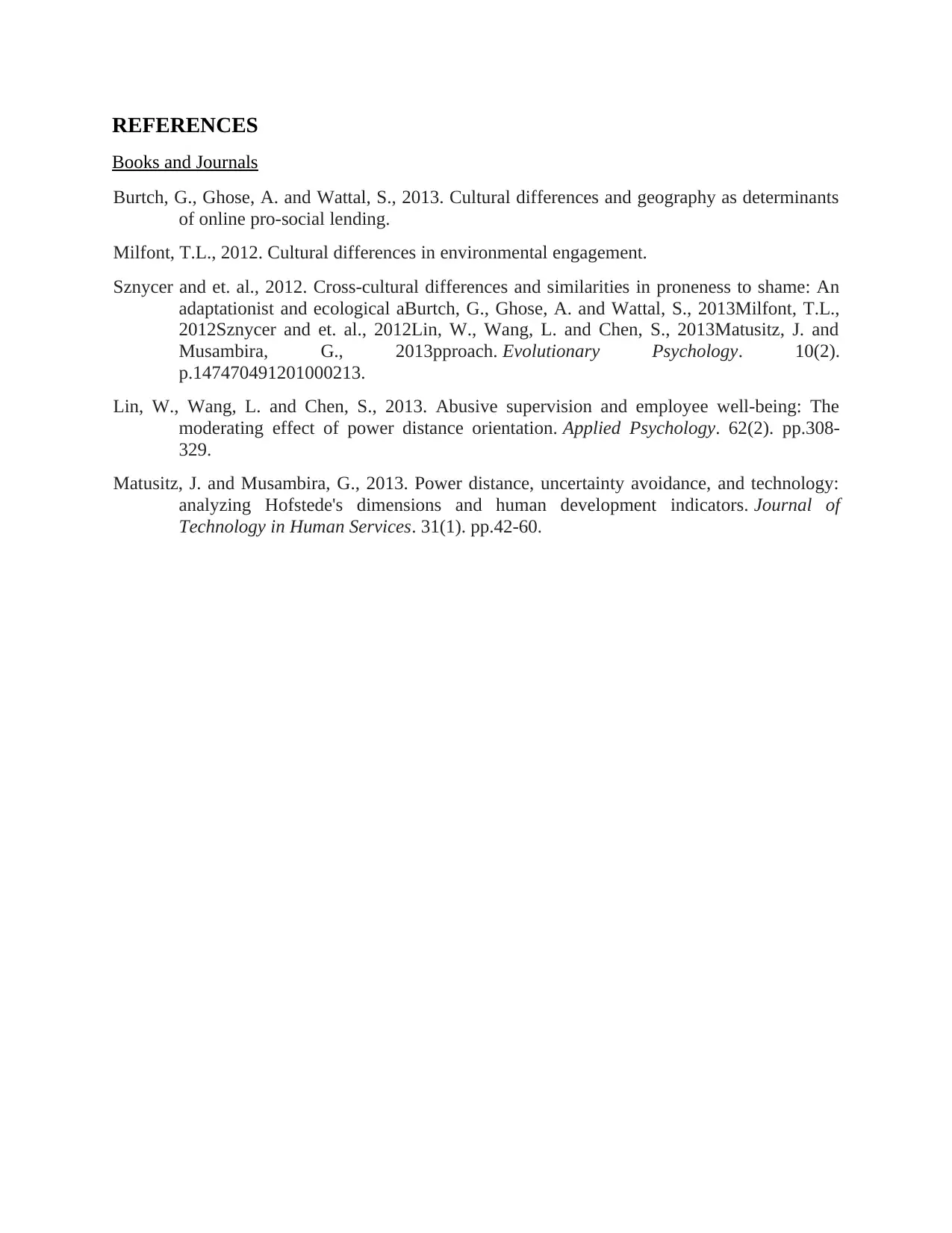
REFERENCES
Books and Journals
Burtch, G., Ghose, A. and Wattal, S., 2013. Cultural differences and geography as determinants
of online pro-social lending.
Milfont, T.L., 2012. Cultural differences in environmental engagement.
Sznycer and et. al., 2012. Cross-cultural differences and similarities in proneness to shame: An
adaptationist and ecological aBurtch, G., Ghose, A. and Wattal, S., 2013Milfont, T.L.,
2012Sznycer and et. al., 2012Lin, W., Wang, L. and Chen, S., 2013Matusitz, J. and
Musambira, G., 2013pproach. Evolutionary Psychology. 10(2).
p.147470491201000213.
Lin, W., Wang, L. and Chen, S., 2013. Abusive supervision and employee well‐being: The
moderating effect of power distance orientation. Applied Psychology. 62(2). pp.308-
329.
Matusitz, J. and Musambira, G., 2013. Power distance, uncertainty avoidance, and technology:
analyzing Hofstede's dimensions and human development indicators. Journal of
Technology in Human Services. 31(1). pp.42-60.
Books and Journals
Burtch, G., Ghose, A. and Wattal, S., 2013. Cultural differences and geography as determinants
of online pro-social lending.
Milfont, T.L., 2012. Cultural differences in environmental engagement.
Sznycer and et. al., 2012. Cross-cultural differences and similarities in proneness to shame: An
adaptationist and ecological aBurtch, G., Ghose, A. and Wattal, S., 2013Milfont, T.L.,
2012Sznycer and et. al., 2012Lin, W., Wang, L. and Chen, S., 2013Matusitz, J. and
Musambira, G., 2013pproach. Evolutionary Psychology. 10(2).
p.147470491201000213.
Lin, W., Wang, L. and Chen, S., 2013. Abusive supervision and employee well‐being: The
moderating effect of power distance orientation. Applied Psychology. 62(2). pp.308-
329.
Matusitz, J. and Musambira, G., 2013. Power distance, uncertainty avoidance, and technology:
analyzing Hofstede's dimensions and human development indicators. Journal of
Technology in Human Services. 31(1). pp.42-60.
⊘ This is a preview!⊘
Do you want full access?
Subscribe today to unlock all pages.

Trusted by 1+ million students worldwide
1 out of 6
Related Documents
Your All-in-One AI-Powered Toolkit for Academic Success.
+13062052269
info@desklib.com
Available 24*7 on WhatsApp / Email
![[object Object]](/_next/static/media/star-bottom.7253800d.svg)
Unlock your academic potential
Copyright © 2020–2025 A2Z Services. All Rights Reserved. Developed and managed by ZUCOL.





